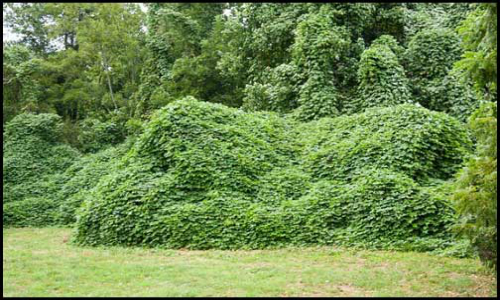There is a vine out there that has been known to take down hydro poles, engulf buildings, and literally smother forests. “The vine that ate the south” is kudzu, a native of eastern Asia that has spread from the United States into Ontario and it looks like British Columbia and Quebec are next.
Apparently the U.S. spends about $500 million a year in the war against kudzu and on one hand I can see why; this plant can grow 30 cm (1’) per day. That is quite remarkable and many call it the “mile a minute” vine. This is a plant that is quite pervasive and its aggressive growth can create what some refer to as being kudzuscapes. Kudzu engulfs 500 square kilometres annually and there are estimates that claim there are about 300,000 square kilometres of land in the United States has been swallowed up by the vine.
Kudzu roots can survive winter but if the temperatures dip to -20°C then this can kill the plant’s root system. If it survives winter, it makes its appearance in spring.
This is one plant that is obviously a major food source that can help many on fixed or low incomes.
Kudzu History in the U.S.
Kudzu was first introduced to America in 1876 at the Philadelphia Centennial Exposition. Farmers planted it extensively throughout the eastern United States as a means of limiting erosion and feeding cattle. Others made clothing from its fibre and extracted starch from its giant sweet-potato-like roots. In fact, according to some sources, the U.S. government paid farmers to grow this plant.
Before long kudzu began to proliferate on abandoned farms as more and more people left their properties and moved to the cities. By the 1950s, it was no longer welcome and measures were put in place to try and control it. The plant, ubiquitous in parts of the U.S. southeast, has become part of the culture. In Georgia for example, it’s common to see old farmhouses, factories, shops and cars engulfed by kudzu.
Kudzu Health Benefits
Interestingly some people have called kudzu the cancer of plants because of the way it can kill everything in its path; yet there is scientific evidence that claims it contains constituents that help prevent cancer. The isoflavones genistein, daidzein and biochanin A all have cytotoxic activity.
The isoflavones daidzein, genistein, formononetin, and biochanin A that are in kudzu also help to fight alcoholism. Kudzu may decrease peak alcohol levels.
Kudzu also helps in other ways such as:
- Anti-bacterial
- Anti-inflammatory
- Antioxidant
- Anti-thrombotic
- Cardiovascular effects: Early preclinical and animal research suggests kudzu has a protective effect against myocardial ischemia and may increase cardiac function.
- Osteoporotic effects: In animal studies, kudzu increased bone mineral density.
Kudzu as Food
Kudzu, has been a popular food in Japan and China for thousands of years. The edible parts of the kudzu plant that are the leaves, vine tips, flower blossoms, and roots. It’s high in fiber, protein and vitamins A and D.
However, it’s the tuberous roots that offer this plant’s real premium. These roots are dehydrated and pulverized, and it is this starchy kudzu powder that is used for cooking in myriad ways from thickening soups and sauces to batter for foods to be deep-fried.
In the early spring and throughout the growing season, harvest the very end of an established kudzu vine where the new growth is forming small shoots and young leaves. Young leaves and vine tips are tender enough for most culinary purposes including in salads. The older, larger leaves are good for dolmades (stuffed leaves).
Kudzu soup, kudzu phyllo, kudzu dolmades, the possibilities are truly endless when it comes to being creative in the kitchen. Remember, if you can’t beat it, you might as well eat it.
I want to express my deepest gratitude to Jack Anthony of Dahlonega, Georgia. He granted me permission to use two of his incredible images, one for this blog and one appears with the photos of kudzu under the plant description. (Thank you Jack.) Please be sure to check out more of his kudzu photography at this link. Also be sure to check out other photography and books authored by Jack by clicking here.
Scientific Sources:
Sigma Aldrich: Kudzu





Why has kudzu not been commercialized?
Good question – wish I knew the answer!
sdassad
Kudzu is not as scary by the way.
You can feed livestock on it, it’s possible to make hay out of it.
Not to mention that cold and dryness keep it in its place.
As to human treatment herbicides and mowing do the trick.
It’s one hell of a wasted resource, you can make paper out of it, even fuel! Aside of that it is edible. I wonder why there are around 30 000 square kilometers of wasted arable, because of it in the US only…
Irvine, professional gardener and horticulture consultant @ http://www.gardenersserviceslondon.co.uk/
Most of the people believe that Kudzu is dangerous and beautiful at the same time but they don’t know that the plant has its benefits. A while ago I read that it was used for making soaps, compost and lotions.
Thank you for showing everybody how Kudzu can be used.
Regards, City Garden Ltd London